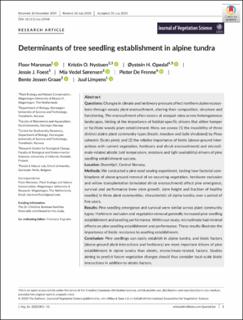| dc.contributor | Marsman, Floor | |
| dc.contributor.author | Nystuen, Kristin Odden | |
| dc.contributor.author | Opedal, Øystein Hjorthol | |
| dc.contributor.author | Foest, Jessie J | |
| dc.contributor.author | Sørensen, Mia Vedel | |
| dc.contributor.author | De Frenne, Pieter | |
| dc.contributor.author | Graae, Bente Jessen | |
| dc.contributor.author | Limpens, Juul | |
| dc.date.accessioned | 2021-03-17T13:40:32Z | |
| dc.date.available | 2021-03-17T13:40:32Z | |
| dc.date.created | 2021-01-21T10:16:47Z | |
| dc.date.issued | 2021 | |
| dc.identifier.citation | Marsman, F., Nystuen, K. O., Opedal, Ø. H., Foest, J. J., Sørensen, M. V., de Frenne, P., Graae, B. J. & Limpens, J. (2020). Determinants of tree seedling establishment in alpine tundra. Journal of Vegetation Science, 32(1): e12948. doi: | en_US |
| dc.identifier.issn | 1654-1103 | |
| dc.identifier.uri | https://hdl.handle.net/11250/2733966 | |
| dc.description.abstract | Questions
Changes in climate and herbivory pressure affect northern alpine ecosystems through woody plant encroachment, altering their composition, structure and functioning. The encroachment often occurs at unequal rates across heterogeneous landscapes, hinting at the importance of habitat‐specific drivers that either hamper or facilitate woody plant establishment. Here, we assess: (1) the invasibility of three distinct alpine plant community types (heath, meadow and Salix shrubland) by Pinus sylvestris (Scots pine); and (2) the relative importance of biotic (above‐ground interactions with current vegetation, herbivory and shrub encroachment) and microclimate‐related abiotic (soil temperature, moisture and light availability) drivers of pine seedling establishment success.
Location
Dovrefjell, Central Norway.
Methods
We conducted a pine seed sowing experiment, testing how factorial combinations of above‐ground removal of co‐occurring vegetation, herbivore exclusion and willow transplantation (simulated shrub encroachment) affect pine emergence, survival and performance (new stem growth, stem height and fraction of healthy needles) in three plant communities, characteristic of alpine tundra, over a period of five years.
Results
Pine seedling emergence and survival were similar across plant community types. Herbivore exclusion and vegetation removal generally increased pine seedling establishment and seedling performance. Within our study, microclimate had minimal effects on pine seedling establishment and performance. These results illustrate the importance of biotic resistance to seedling establishment.
Conclusion
Pine seedlings can easily establish in alpine tundra, and biotic factors (above‐ground plant interactions and herbivory) are more important drivers of pine establishment in alpine tundra than abiotic, microclimate‐related, factors. Studies aiming to predict future vegetation changes should thus consider local‐scale biotic interactions in addition to abiotic factors. | en_US |
| dc.language.iso | eng | en_US |
| dc.publisher | Wiley | en_US |
| dc.rights | Navngivelse 4.0 Internasjonal | * |
| dc.rights.uri | http://creativecommons.org/licenses/by/4.0/deed.no | * |
| dc.title | Determinants of tree seedling establishment in alpine tundra | en_US |
| dc.type | Peer reviewed | en_US |
| dc.type | Journal article | en_US |
| dc.description.version | publishedVersion | en_US |
| dc.rights.holder | © 2020 The Author(s) | en_US |
| dc.subject.nsi | VDP::Matematikk og Naturvitenskap: 400 | en_US |
| dc.subject.nsi | VDP::Matematikk og Naturvitenskap: 400::Zoologiske og botaniske fag: 480::Økologi: 488 | en_US |
| dc.subject.nsi | VDP::Landbruks- og Fiskerifag: 900::Landbruksfag: 910::Planteforedling, hagebruk, plantevern, plantepatologi: 911 | en_US |
| dc.source.pagenumber | 15 | en_US |
| dc.source.volume | 32 | en_US |
| dc.source.journal | Journal of Vegetation Science | en_US |
| dc.source.issue | 1 | en_US |
| dc.identifier.doi | 10.1111/jvs.12948 | |
| dc.identifier.cristin | 1876293 | |
| dc.description.localcode | Paid Open Access | en_US |
| dc.source.articlenumber | e12948 | en_US |

